This article is about transport in Oman.
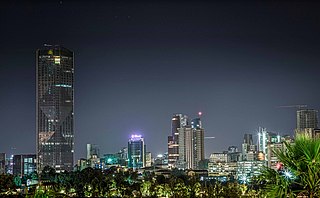
Addis Ababa is the capital and largest city of Ethiopia. In the 2007 census, the city's population was estimated to be 2,739,551 inhabitants. Addis Ababa is a highly developed and important cultural, artistic, financial and administrative center of Ethiopia. It is widely known as one of Africa's capitals.
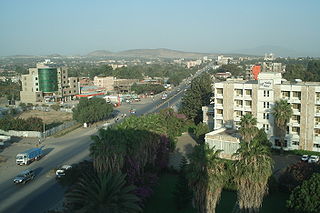
Adama, formerly Nazreth, is a one of the cities of Oromia Region of Ethiopia. Located in the East Shewa Zone 99 km (62 mi) southeast of the capital, Addis Ababa, the city sits between the base of an escarpment to the west, and the Great Rift Valley to the east.

Awash Subah is a market town in central Ethiopia. Located in Administrative Zone 3 of the Afar Region, above a gorge on the Awash River, after which the town is named, the town lies on the Addis Ababa–Djibouti Railway, which crosses the gorge by a bridge there. It is the largest settlement in Awash Fentale woreda.
Rail transport in Ethiopia is done within the National Railway Network of Ethiopia, which currently consists of three electrified standard gauge railway lines: the Addis Ababa–Djibouti Railway, the Awash–Weldiya Railway and the Weldiya–Mekelle Railway. Other lines are still in the planning phase. There is also an urban light rail system in the country's capital, the Addis Ababa Light Rail.
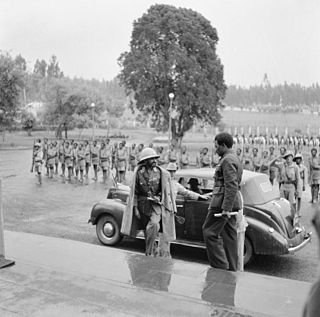
The history of Addis Ababa, capital of Ethiopia, formally begins with the founding of the city in the 19th century by Ethiopian Emperor Menelik II and his wife Empress Taytu Betul. In its first years the city was more like a military encampment than a town. The central focus was the emperor’s palace, which was surrounded by the dwellings of his troops and of his innumerable retainers. In the 1920s, Addis Ababa experienced a significant economic upturn, marked by a surge in the number of middle-class-owned buildings, including stone houses furnished with imported European furniture. The middle class also introduced newly manufactured automobiles and expanded banking institutions. Urbanization and modernization persisted during the Italian occupation, guided by a masterplan aimed at transforming Addis Ababa into a more "colonial" city, a trajectory that continued beyond the occupation. Subsequent master plans, formulated from the 1940s onward with the input of European consultants, focused on the development of monuments, civic structures, satellite cities, and the inner city.

Current railway stations in Ethiopia are served by standard gauge railways of the National Railway Network of Ethiopia which is mostly under construction, except the Addis Ababa–Djibouti Railway. Other stations were built for the in 2018 still operating metre gauge Ethio-Djibouti Railways, although this railway has officially been superseded by the new Addis Ababa-Djibouti Railway.

The Ethio-Djibouti Railway is a metre gauge railway in the Horn of Africa that once connected Addis Ababa to the port city of Djibouti. The operating company was also known as the Ethio-Djibouti Railways. The railway was built in 1894–1917 to connect the Ethiopian capital city to French Somaliland. During early operations, it provided landlocked Ethiopia with its only access to the sea. After World War II, the railway progressively fell into a state of disrepair due to competition from road transport.
Rail transport in Djibouti is administered through the Ethio-Djibouti Standard Gauge Rail Transport Share Company, a bi-national company between Ethiopia and Djibouti to manage the only railway in Djibouti, the electrified standard gauge international Addis Ababa–Djibouti Railway. This railway opened on 1 January 2018 replaced the international metre gauge railway from Djibouti's capital Djibouti City to the Ethiopian capital Addis Ababa, which was officially decommissioned in 2016.

People's Republic of China–Ethiopia relations were established in 1970. Ethiopia has an embassy in Beijing and the People's Republic of China has an embassy in Addis Ababa.
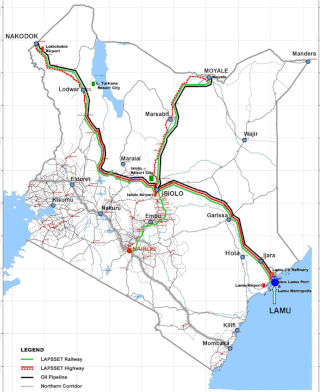
Lamu Port-South Sudan-Ethiopia-Transport (LAPSSET) Corridor project, also known as Lamu corridor is a transport and infrastructure project in Kenya that, when complete, will be the country's second transport corridor. Kenya's other transport corridor is the Northern Corridor, which links Mombasa to Uganda, passing through Nairobi and much of the Northern Rift. Some basic LAPSSET infrastructure has been built. The construction of LAPSSET's main components is currently ongoing with construction of the first berth at Lamu Port completed in October 2019.. Although the project is not formally stalled, its short to medium term success looks increasingly unlikely. Insecurity and political instability in Kenya are mostly to blame for this, as are more commercially viable alternative pipeline options through Tanzania or Ethiopia. The low oil prices since 2015 also affect LAPSSET's commercial prospects.
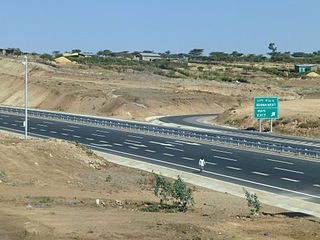
The Addis Ababa–Adama Expressway is a toll road that connects Addis Ababa to Adama. It is the first expressway in Ethiopia. The road was built between 2010 and 2014 by the China Communications Construction Company. The government opened the highway for traffic on September 14, 2014. The Government of Ethiopia covered 43 percent of the road's construction cost, while the remaining 57 percent was supplied by a loan from the Exim Bank of China.

The Addis Ababa–Djibouti Railway is a standard gauge international railway that serves as the backbone of the new Ethiopian National Railway Network. The railway was inaugurated by Prime Minister Hailemariam Desalegn on January 1, 2018. It provides landlocked Ethiopia with access to the sea, linking Ethiopia's capital of Addis Ababa with Djibouti and its Port of Doraleh. More than 95% of Ethiopia's trade passes through Djibouti, accounting for 70% of the activity at the Port of Djibouti.
The Djibouti Ports & Free Zones Authority (DPFZA) is the governmental body of Djibouti that administers and manages the Port of Djibouti and several other facilities in the country. The DPFZA also oversees the management of Djibouti International Free Trade Zone, serving as a liaison between the companies based there and other governmental agencies. The DPFZA reports directly to the Presidential Office.

The Awash–Weldiya Railway is a standard gauge railway under construction, that will serve as a northward extension of the new Ethiopian National Railway Network.

The Weldiya–Mekelle Railway is a standard gauge railway under construction, that will serve as a northward extension of the new Ethiopian National Railway Network and connects Mekelle to Addis Ababa and Djibouti via the Awash-Weldiya railway.
The A1 Road is a road in Ethiopia that spans a total distance of 802 kilometers. The road traverses an arc-shaped route through the central and eastern regions of the country, connecting the capital city Addis Ababa to the border with Eritrea at Bure. The route passes through Adama and Awash. Additionally, a branch of the A1 extends to the border with Djibouti, providing a link between Ethiopia and its neighboring countries.
The A2 Road is a national route in Ethiopia.It serves as a principal trunk highway for an entire distance of 1,013 kilometers. The road runs from north to south from Addis Ababa to Eritrea. The A2 is important in making transport and trade easy between the central highlands with northern parts of Ethiopia.
The Adama–Awash Expressway is a national route in Ethiopia currently under construction designed to link the cities of Adama and Awash, located in the central region of the country. Upon completion, the Adama–Awash Expressway will span a total length of 130 kilometers, contributing significantly to the expansion and modernization of Ethiopia's road network. The development is expected to have a positive impact on the country's economic growth, trade, and social development, while also improving travel times and overall transportation safety.

















